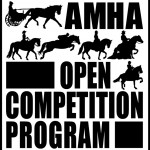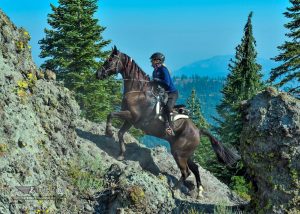Gaits Made Simple.
TRAIL TRAINING
Gaits Made Simple
Understanding a horse’s gait may not be as simple as you think. Our author discusses various gaits horse’s employ, how to understand them and how to train your horse to use his natural gait on cue.
BRENDA IMUSAUG 31, 2006 From Horse and Rider
“I know my horse has a smooth saddle gait,” a gal told me at one of my clinics. “When we’re headed for home or he’s rushing to catch up with other horses, it suddenly feels like I’m gliding along on ball bearings. But I don’t know how to achieve that gait the rest of the time. When I try to push him for more speed, he gets very choppy and hard to ride, especially going downhill.”
Have you ever had this problem with your gaited horse? To produce his smoothest saddle gait on cue, you first need to understandhowhe gaits.
Every smooth saddle gait falls somewhere on a spectrum between the perfectly diagonal two-beat trot, and the perfectly lateral two-beat pace. Here, I’ll go over six intermediate saddle gaits: the diagonal gaits (trot and fox trot), the lateral gaits (pace and stepping pace), and the square gaits (walk and running walk). But first, I’ll explain your gaited horse’s unique, inborn talent to work each leg independently from every other leg to produce a smooth ride.
A Unique Talent
Most gaited saddle horses possess a unique quality I termquadridexterity.Just as people are eithermonodextrous(left- or right-handed) orambidextrous(proficient with either hand), horses are either ambidextrous or what I callquadridextrous.
Most people write predominantly with their right hand or left hand. Most of us can do some elementary writing or drawing with our nondominant hand. But if we try to do so with any speed or precision, we soon discover that we’re hardwired to be either right- or left-handed. With practice, ambidextrous people can become equally adept with both hands.
Horses, having four legs, arediagonallyorlaterally ambidextrous.A diagonally ambidextrous horse moves his twodiagonal(opposite side) legs together in perfect, two-beat synchrony: left hind/right fore; right hind/left fore. This constitutes a trot; trotting horses might be likened to right-handed people.
A pacing horse is laterally ambidextrous. He moves his two lateral (same side) legs together in perfect, two-beat synchrony: right fore/right hind; left fore/left hind. Pacing horses might be likened to less common left-handed people.
In either case, there’s generally a moment of suspension when the set of diagonal or lateral legs lifts from the ground before the other set comes down. The concussion or jarring you feel during the trot or pace is the result of the horse’s weight dropping back down to earth at the beginning of each new stride.
On the other hand, a naturally smooth-gaited horse uses each leg independently of every other leg. That’s what I call quadridextrous. And just as ambidextrous people can improve their ability to use each hand independently, quadridextrous horses, too, need to be brought along carefully to properly develop their natural ability to its full potential. This in mind, here’s a look at gait mechanics.
Image placeholder title
The Diagonal Gaits
At the diagonal end of the gait spectrum are thetrotand thefox trot.
The trot.The trot is a perfectly timed, two beat gait whereby two sets of diagonal legs (right hind/left front; left hind/right front) pick up and set down in perfect, two-beat rhythm, with a moment of suspension and resultant concussion between strides.
The fox trot.The fox trot is similar to the trot in that each set of diagonal legs move somewhat in unison, but the forefoot lands a microsecond before the diagonally opposed hind foot, breaking the two-beat rhythm. This action eliminates suspension/concussion, and creates an uneven, four-beat gait: 1-2-3-4-1-2-3-4. (This rhythm closely mimics the sound of the phrase: “Hunk o’ meat and peck o’ potatoes.”) A naturally fox trotting horse generally has a long, low, reaching stride in front, and a higher, lifting stride behind. He looks as though he’s “walking in front and trotting behind.”
Image placeholder title
The Lateral Gaits
At the opposite, lateral end of the gait spectrum are thepaceand thestepping pace.
The pace.Thepaceis a perfectly timed two beat gait whereby the right hind/right fore and left hind/left fore pick up and set down in perfect, two beat rhythm. There’s a moment of suspension/ concussion with each stride. The pace horse also tends to throw his rider from side to side as he swings his body to accommodate the paces’ extreme lateral action.
The stepping pace.Thestepping paceis nearly identical to the pace, except that the hind foot lands a split instant before the same-side forefoot. This eliminates suspension/concussion, and turns it into an imperfectly timed four-beat gait: 1-2-3-4-1-2-3-4.
The stepping pace is smooth to ride, but presents inherent problems for both horse and rider. First, when a stepping pace is speeded up, it tends to turn into a rough two-beat pace. More important, this gait can create a hollow, strung-out body frame. Too much of the horse’s body weight is carried on the forehand, then suspended for too long over his hyperextended rear leg. This is why strongly oriented lateral horses tend toward hollow backs, saddling problems, and potentially serious hock and stifle issues. Therefore, encourage your horse to develop a more evenly timed gait; that is, to fox trot, if that’s what he’s built and wired to do. Fortunately, teaching a laterally oriented horse to square up isn’t all that difficult; I’ll discuss training in future issues.




